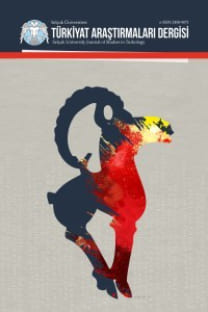BİR DİL SÜRÇMESİ TÜRÜ OLARAK ÇAPRAZLAMA VE TÜRKÇE ÖRNEKLER BAĞLAMINDA YAPISAL ÖZELLİKLERİ
Dil sürçmesi, çaprazlama, konuşma hataları, dil yetisi
SPOONERISM AS A SLIP OF THE TONGUE AND ITS STRUCTURAL CHARACTERISTICS IN THE CONTEXT OF TURKISH EXAMPLES
Slip of the tongue spoonerism, crosswise, speech errors, language competence,
___
- AKSAN, Doğan (1995), Her Yönüyle Dil, Ana Çizgileriyle Dilbilim, Ankara: Türk Dil Kurumu Yayınları.
- BAARS, Bernard J. (1992), Experimental Slips and Human Error: Exploring the Architecture of Volition, New York: Springer.
- BANGUOĞLU, Tahsin (2011), Türkçenin Grameri, Ankara: Türk Dil Kurumu Yayınları.
- CARROLL, David W. (2008), Psychology of Language, Belmont: Thomson West.
- CÖNTÜRK, Hüseyin (2006), Çağının Eleştirisi - Birinci Kitap (haz. Ege Berensel), İstanbul: Yapı Kredi Yayınları.
- CUTLER, Anne (1982), Slips of the tongue, The Hague: Mouton.
- DELL, Gary S. (1986), A spreading-activation theory of retrieval in sentence production, Psychological Review 93, 283-321.
- DTS=Komisyon (1949), Dilbilim Terimleri Sözlüğü, Ankara: Türk Dil Kurumu Yayınları.
- ERGİN, Muharrem (2004), Türk Dil Bilgisi, İstanbul: Bayrak Basım/Yayın/Tanıtım.
- FREUD, Sigmund (1995), The Basic Writings of Sigmund Freud (çev. A. A. Brill), New York: Random House.
- FROMKIN, V. A. (ed.) (1973), Speech Errors as Linguistic Evidence, The Hague: Mouton
- FROMKIN, Victoria A. (ed.) (1980), Errors in Linguistic Performance: Slips of the Tongue, Ear, Pen and Hand, New York: Academic Press.
- GOLDSTEIN, Bruce E. (2008), Cognitive Psychology: Connecting Mind, Research, and Everyday Experience, Belmont: Thomson Wadsworth.
- HOFSTADTER, R. Douglas (1995), Speechstuff and Thoughtstuff: Musings on the Resonances Created by Words and Phrases via the Subliminal Perception of their Buried Parts, Of Thoughts and Words: The Relation between Language and Mind, Proceedings of the Nobel Symposium 92. (ed. Sture Allén). London/New Jersey: World Scientific Publishing, 217-267.
- HORBERRY, Roger (2010), Sounds Good on Paper: How to Bring Business Language to Life, London: A & C Black.
- KARAAĞAÇ, Günay (2013), Dil Bilimi Terimleri Sözlüğü, Ankara: Türk Dil Kurumu Yayınları.
- KEMMERER, David (2015), Cognitive Neuroscience of Language, New York and London: Psychology Press.
- POTTER, John M. (1980), What was the matter with Dr. Spooner?, Errors in Linguistic Performance: Slips of the Tongue, Ear, Pen and Hand (ed. V. A. Fromkin), New York: Academic Press, 13-34.
- SMYTH, Mary M., Alan F. Collins, Peter E. Morris, Philip Levy (2000), Cognition in Action, Hove: Psychology Press.
- SOFU, Hülya (2001), Dil Sürçmeleri, XV. Dilbilim Kurultayı Bildiriler Kitabı (ed. Ömer Demircan ve Aybars Erözden), İstanbul: Yıldız Teknik Üniversitesi Basım-Yayın Merkezi.
- TA=Komisyon (1963), Türk Ansiklopedisi, C. XI, Ankara: Milli Eğitim Basımevi.
- USTA, Çiğdem (2005), Mizah Dilinin Gizemi, Ankara: Akçağ Yayınları.
- WARREN, Paul (2013), Introducing Psycholinguistics, Cambridge: Cambridge University Press.
- ISSN: 1300-5766
- Yayın Aralığı: 3
- Başlangıç: 1994
- Yayıncı: Selçuk Üniversitesi
I. DÜNYA SAVAŞI SONUNDAN CUMHURİYET’İN İLK YILLARINA KADAR HARP KAZANÇLARI VERGİSİ (1919-1925)
KIRGIZ TÜRKLERİNDE ÖLÜM VE ÖLÜM ÖNCESİ İNANIŞLAR
KAÇAR VE OSMANLI DEVLETLERİ ARASINDA BELİRSİZ SINIR MESELELERİ
MEŞHED NÜSHASI TÜRKÇE KUR’AN TERCÜMESİNİN SÖZ VARLIĞI ÜZERİNE NOTLAR
TÜRKMEN TÜRKÇESİNDE “hem” BAĞLACININ TİPİK BİR KULLANIMI
Yakup KARASOY, Orhan YAVUZ, İbrahim YILMAZ
TARİH VE KÜLTÜREL İLETİŞİM EKSENİNDE NAZEMİN M. GELEN’İN HASAN BULLİLER ROMANINI YENİDEN YORUMLAMAK
Mustafa YENİASIR, Burak GÖKBULUT
ABDULLAH EFENDİ’NİN RÜYALARI HİKÂYESİNDE KORKUNUN HÜKÜMRANLIĞI
